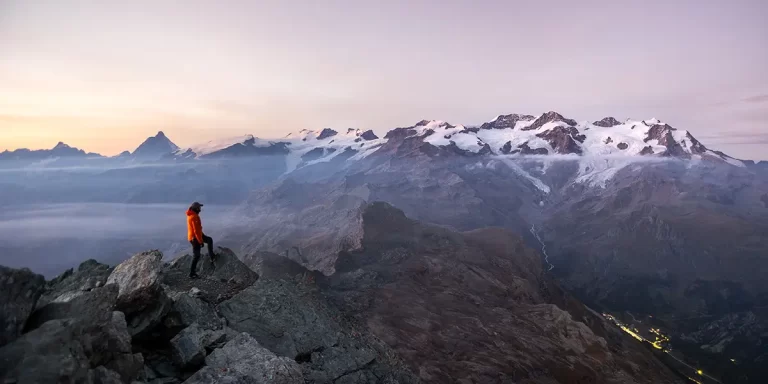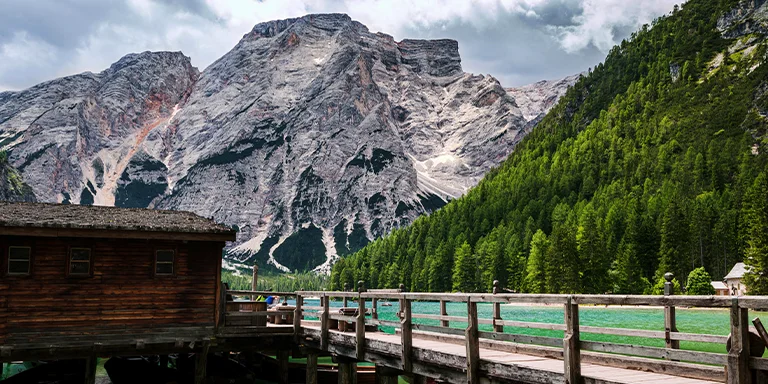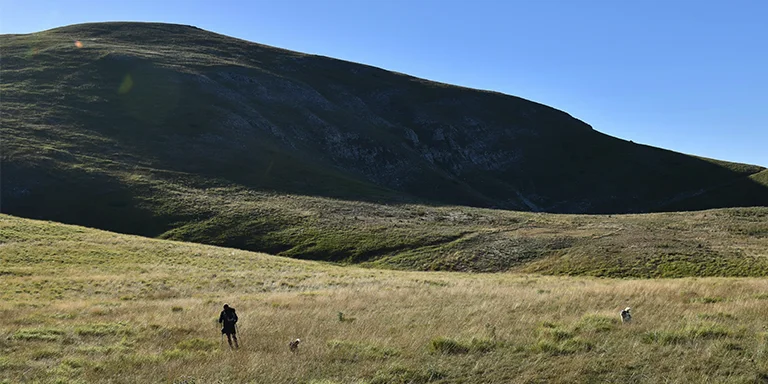

Backpacking in Italy offers immense variety for outdoor enthusiasts, from the storied Dolomites to windswept coastal trails, including popular destinations like the Cinque Terre.
And that’s what this post is all about – backpacking in Italy. We’ll provide tips to help you prepare for backpacking in this diverse country as well as showcase the TOP 5 multi-day trails in Italy.
Interested? Let’s get started planning an epic Italian backpacking trip!
Italy offers outstanding multi-day trails with resupply points available every two days:

Length: 74 mi / 119 km
Type: Point to point
Difficulty: Hard
Elevation Gain: 25075 ft / 7642 m
Location: Fanes-Senes-Braies Nature Park
Estimated Hiking Calorie Burn: 7743 calories
More Details: See on AllTrails
This challenging 74-mile point-to-point trail runs from Lake Braies to Belluno in Italy’s Dolomites. Considered one of the most beautiful hikes in the Alps, Alta Via 1 traverses incredible mountain landscapes with cliffs, valleys, and vertical walls. The route includes sections of via ferrata, requiring proper climbing equipment. Overnight stays are possible in local refuges. While demanding, the epic scenery makes it a rewarding adventure from June to September.

Mongolo1984, CC BY-SA 4.0, via Wikimedia Commons
Length: 81.7 mi / 131.5 km
Type: Point to point
Difficulty: Hard
Elevation Gain: 15396 ft / 4693 m
Location: Gessi Bolognesi and Calanchi dell’Abbadessa Regional Park
Estimated Hiking Calorie Burn: 7304
More Details: See on AllTrails
The challenging 81-mile Via Degli Dei point-to-point trail connects Bologna to Florence through the Tuscan-Emilian Apennines. Traversing breathtaking mountain scenery with ancient Etruscan roads, this 6-segment journey features Monte Venere, Monte Giunone, and Monte Luario. Well-marked but substantial ascents and descents require planning for water and overnight stays. Rewarding for experienced backpackers seeking stunning vistas along a historical route.

Length: 99.4 mi / 160 km
Type: Point to point
Difficulty: Hard
Elevation Gain: 39291 ft / 11976 m
Location: Bressanone
Estimated Hiking Calorie Burn: 10969 calories
More Details: See on AllTrails
This challenging 99-mile point-to-point trail from Bressanone to Feltre traverses the stunning mountain landscapes of the Dolomites range. With cliffs, valleys, and peaks over 3,000 meters, Alta Via 2 is known as the “Way of Legends” for its mystic tales and locales. Technical sections require surefootedness, but spectacular alpine scenery makes it a rewarding summer pursuit for experienced backpackers. Staying at cozy mountain refuges, Alta Via 2 provides a memorable Dolomites adventure through 13 segments and 30 mountain passes.

Length: 33.6 mi / 54.1 km
Type: Loop
Difficulty: Moderate
Elevation Gain: 3353 ft / 1022 m
Location: Curon Venosta
Estimated Hiking Calorie Burn: 2711 calories
More Details: See on AllTrails
This moderately challenging 34-mile loop around Reschensee in Italy’s South Tyrol follows the shores of the scenic reservoir and passes the striking bell tower in the lake, once part of a sunken village. Starting from San Valentino, the trail connects Reschensee and Lago di Muta, featuring the villages of Curon Venosta and Graun. Popular mainly for hiking from April to October, the Reschensee Loop showcases the spectacular mountain scenery of the Upper Vinschgau Valley.

Length: 31.4 mi / 50.5 km
Type: Loop
Difficulty: Hard
Elevation Gain: 6033 ft / 1839 m
Location: Stelvio National Park
Estimated Hiking Calorie Burn: 2803 calories
More Details: See on AllTrails
This moderately challenging 31-mile loop starts from the ski town of Livigno, Italy and traverses mountain passes along the Swiss border. Following Lake Livigno and crossing into Switzerland, the trail summits Alpisella Pass, Fraele Pass, and Val Mora Pass before returning to Italy via Gal Pass. Offering alpine solitude and views, the Livigno Loop showcases the beauty of the Italian/Swiss Alps border region.
Italy has a diverse climate due to its geographical features, and weather conditions can vary depending on the region and the time of year. Here’s a general overview:
Before choosing your gear, check the weather data for Italy (Milan).
| Jan | Feb | Mar | Apr | May | Jun | Jul | Aug | Sep | Oct | Nov | Dec | |
|---|---|---|---|---|---|---|---|---|---|---|---|---|
| High °F | 41 | 50 | 60 | 67 | 76 | 83 | 87 | 87 | 78 | 66 | 54 | 46 |
| Low °F | 35 | 33 | 40 | 47 | 56 | 63 | 67 | 66 | 59 | 51 | 41 | 33 |
| Rain/Snow (D*) | 7 | 7 | 8 | 8 | 8 | 8 | 6 | 7 | 5 | 7 | 9 | 6 |
Not sure if Italy is right for you?
Don’t forget to check out our backpacking guides for Switzerland and France.
Campfires are heavily restricted while backpacking in Italy and require advance planning and permits. Lighting fires is prohibited in many protected natural areas. Research specific regulations which vary by municipality and national/regional park. Obtain required permits early if building fires is conditionally allowed only at designated campsites. Camp stoves are a safer alternative for cooking to minimize risk of uncontrolled burns.
When backpacking through Italy, packing light is key to mobility. Focus on versatile travel clothes, hiking shoes, rain jacket, first aid, guidebook, small day pack, phone charger and other essentials. Thoroughly research routes and trails using guidebooks, maps and local sources to understand difficulty levels and conditions. Make copies of documents, leave one at home, and keep the other separate while traveling in case of loss or theft. To stay safe in cities, blend in with locals by dressing stylishly, avoiding looking like an obvious tourist, and being aware of pickpockets. Respect Italian cultural norms, traditions and laws as you explore cities, towns and rural areas. Connect with locals to appreciate the heritage. Use common sense precautions, informed route planning, proper gear, and cultural awareness to safely experience Italy’s landscapes, cuisine and artistic treasures.
Packing light, blending in, respecting local culture and doing thorough route research allows you to safely traverse the terrain while soaking in the magic of Italy. Focus your packing on essentials for the trail and cities. Secure belongings against theft and make document copies. By being a thoughtful, responsible backpacker you can immerse yourself in Italy’s cultural treasures while wandering its stunning natural landscapes. Use travel smarts to explore safely.
When you’re hiking in Italy, stay alert and make noise to avoid surprising wildlife. Give plenty of space to wild boars, wolves, bears, and other creatures. Don’t approach, feed, or try to touch them. After hiking, wear insect repellent and check for ticks to prevent disease. Be careful around marmot burrows in alpine areas. If you come across free-roaming dogs protecting livestock, calmly back away. Seek medical care right away for any bites or scratches.
U.S. citizens do not need a visa for tourist stays of up to 90 days in Italy within a 180-day period. To enter Italy, U.S. citizens need a valid passport that will not expire for at least 3 months beyond the intended departure date from Italy. While no visa is required, travelers should ensure their passport is stamped upon entry and departure as proof of legal stay.